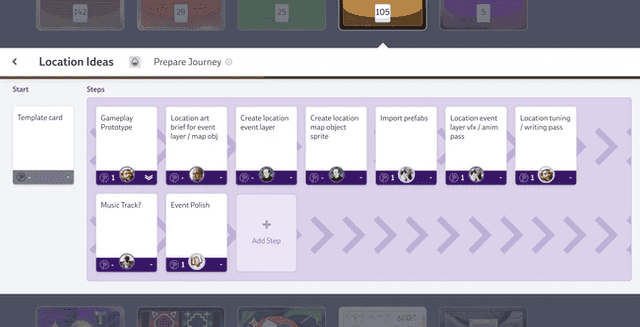
Gonçalo is the Head of Marketing at Codecks. He’s a big Pokémon fan (he has a tiny Bulbasaur right next to his work computer and a big Psyduck in his living room), still raves frequently about how much he loved Shadow of the Colossus (it’s been almost 20 years, Gonçalo!), and truly believes Codecks is *the* tool to turn ideas into videogames.
Codecks is a project management tool inspired by collectible card games. Sounds interesting? Check out our homepage for more information.
How to Avoid Scope Creep in Game Development: Tips and Best Practices

From the many buzzwords and topics that have popped up more and more in the game development industry in the last few years, “scope creep” is easily one of the biggest—and scariest. It’s often the first stop on a downhill train that also stops at “crunch”, “technical debt”, “burnout”, and more, giving you a ride through some of the worst nightmares for game developers everywhere. The way to skip the ride? Well, that’d be to avoid scope creep altogether, of course! And to help you do just that, we wrote this blog post.
Similar to feature creep and over-scoping, scope creep describes when a project’s scope increases due to new features or other changes, often leading to missed deadlines, overblown budgets, worse quality control, frustrated game developers, and basically all the things that can make game development very, very difficult. If uncontrolled, scope creep can derail entire projects, making game developers’ lives hell in the process—and ultimately creating a game that doesn’t fulfill its potential.
Scope creep in game development and how to avoid it is one of the things we think about all the time here at Codecks, and one of the reasons why we even built Codecks in the first place: to create a project management tool specifically for game development that can help game developers everywhere (and game designers, game producers…) avoid all the common pitfalls of turning a game idea into reality, scope creep among them. As such, and with Codecks being a tool made by and for game developers, we have quite a bit of insight and tips to share on how to avoid this pitfall—and, in this blog post, we nail it all down. So let’s get started, and let’s go through a set of ten tips and best practices to have in mind throughout your game development journey, one by one.
1. Define Clear Objectives from the Start
It’s important you understand what the main core of your game is, right from the beginning. What feelings do you want it to evoke? What’s the fantasy the game is trying to accomplish? How would you describe the game in one phrase, one tagline? If this is set, it’s something you can always go back to throughout development.
That’s why it’s important you have a well-documented vision for the game, even before said development starts. This includes a Game Design Document (GDD), outlining the core concept of the game. By building a strong foundation, you can keep the original goals present throughout the entire development, and easily compare new ideas vs. old ones—avoiding any unnecessary deviations in the process. Not sure how to create a GDD? Don’t worry, we’ve also written a blog post on how to create a modern, efficient Game Design Document.
2. Take Note of Your Resources
Just as important as having clear objectives is understanding what you have at your disposal to actually achieve said objectives. How big is your team? What’s your budget? Is there a timeline? Early on, take note of all of these, and tie them to your core vision. Make sure you have a business plan, and lay down the constraints you’re dealing with; be realistic. Make sure your budget covers every step of development and aligns with a timeline (if there is one), and this will help make the process of making your game a lot easier. Plan for what you have, not for what you wish you had.
3. Use the Right Tool for Planning and Management
I mean, Codecks wouldn’t exist if we didn’t think this was important, right? A reliable game development planning tool is essential for keeping your team aligned, organized, and, if you’re using one as playful and resourceful as Codecks, it can also be a good way to foster collaboration and creativity. It’s by using a proper planning and project management tool that you can turn your project into manageable tasks, set realistic deadlines, and track progress. This allows you to then also create a structured roadmap, ensuring every team member knows their responsibility, where they fit in the big picture, and avoids any unnecessary extra steps or work—avoiding scope creep, too.
4. Prioritize Features with a Clear Scope and Goal
When it comes to creating a game, not all features are equally important. Prioritization is essential in every aspect of game development, but particularly when it comes to deciding which features come first—and last. [Use a prioritization framework like MoSCoW (Must-have, Should-have, Could-have, Won’t-have)](https://www.productplan.com/glossary/moscow-prioritization/#:~:text=The acronym MoSCoW represents four,MoSCoW to mean “wish.”) or RICE (Reach, Impact, Confidence, Effort) to categorize features based on their importance, ensuring you and your team focus on what truly matters to the core gameplay experience, spending less time on less critical additions.
5. Document Changes as They Happen
“Ch-ch-ch-changes!” sang David Bowie back in 1971, and, to be honest, he could’ve been singing about game development (he wasn’t, but he could have)! Changes are inevitable and even a necessity when making a game, and things can change radically from one day to the next—which is why it’s important to document things as they happen. When working on a game, you can often go from A to B to C and then back to A again, and you need to document and keep track of things so that you know exactly what each stage was. Keep in mind that people may come and leave the project, features may come and go, and it’s important to always have documentation you can rely on.
Here’s where a game dev project management tool like Codecks can also help, allowing you to document and assess these changes. Tools like Discord or Slack can be fleeting, and conversations can be forgotten or lost—but things like a Hero card are always there, and can always be used to understand the original goal of something, or how a feature or design looks now vs. what it looked like before. That’s also one of the advantages of using Codecks: just by using it, you’re automatically creating documentation, every single day.
6. Communicate Transparently with Your Team, Stakeholders and Community
Be it your internal team, publishers, or community, keeping stakeholders informed about progress (and limitations!) is critical. Regular updates through sprint reviews, milestone check-ins, or development diaries help set realistic expectations and reduce the pressure to include last-minute changes or deviate from the original goal. It’s important stakeholders are kept aware of what the game will actually be like, instead of letting them create that idea in their minds themselves. That’s why Codecks integrates directly with Discord, too!
7. Set Realistic Timelines (and Buffers!)
Have you ever heard a game developer say “Oh, that went faster than expected”? Probably not, and for a good reason: when it comes to making games, things always take longer than you expect. With this in mind, it’s good to be optimistic, but unrealistic optimism can be a pitfall. While you should aim high and be ambitious, underestimating time requirements can lead to rushed additions and poorly integrated features. That’s why you should build in time buffers for unexpected hurdles and, again, use a game development planning tool to set realistic timelines for each phase. And if you have buffers already… double them, if you can! Believe us: no matter what it is, it’ll take longer than you expect.
8. Encourage Iteration… Within Constraints
As essential as iteration is in game development and as necessary as it is to create great games, it’s equally essential to keep it controlled. Set fixed windows for prototyping and testing new ideas, and lock down the scope. By doing this you kill two bugs with one stone: you ensure creativity is still part of the process, and you keep development moving forward. The milestones and sprint features at Codecks (or runs, as we call our sprints) are particularly useful for this, allowing you to segment work chronologically.
9. Monitor Progress Regularly
Frequent progress reviews help identify any potential mishaps early, and are essential for avoiding any potential future scope creep. Constantly monitor and report on both individual tasks and also the overall stage of the game, to ensure everything is moving along the way it should. Being game developers ourselves, we know exactly how important reporting is and what we need from it—which is why we’ve worked so hard to ensure Codecks provides just that. Our milestones and sprints features are also useful here, giving you a visual representation of your weekly (or monthly) progress.
10. Create a Culture of Focus
Last but not least: scope creep is a team challenge (and, when it happens, a team pain). It can come at any stage, and from any aspect of game development—remember, it’s called scope creep because… it creeps on you! As such, encourage your team to value quality over quantity, and remind them of the importance of shipping a polished product. By ensuring everyone is working together towards the same vision, you can collectively resist the temptation to endlessly expand the game’s scope—keeping scope creep at bay. Here are some specific best practices that can help you with this:
-
Minimize multitasking: Encourage team members to focus on one task at a time, instead of spreading themselves thin over several.
-
Encourage ownership and responsibility: Empower people in the team to take ownership of their specific tasks or areas within the project. This sense of accountability will create more focus, and higher quality.
-
Celebrate wins and milestones: The previous point and this one go hand in hand. Celebrate not just the team’s but also individual achievements—value people for their work, and reinforce their work’s importance.
-
Cultivate respect across different teams and roles: Make sure everyone understands the value of every role in the project, from creative to technical to production-focused team members. Create an environment where everyone matters and where every role is equally important. As we talk more about below, tensions when making a game can happen, and a culture of focus and this point specifically can help offset that.
Going back to the essential idea of “less is more” and “quality over quantity”, chess is a good example. Chess is, arguably, a perfect game. It’s simple, easy to learn, has a minimal set of rules, and yet there are more possible unique chess games than stars in the galaxy. This is an example of how deep and complex chess can be, in all its simplicity. In chess, nothing can be added, and nothing can be taken out—it is, as it is, perfect. In game development, there are two schools of thought: one believes a game is complete when there’s nothing left to add, while the other that a game is finished when there’s nothing left to take away. Us? We’re fans of the first… and we think that’s a better way to avoid scope creep.
Going into another topic, but still speaking about culture, it’s also important to note that, as we mentioned above, when making a game, tension within (and between) teams can happen. Someone whose job is, for example, to make sure production sticks to the budget might at some point clash with someone whose job lies more in creating new ideas. Fostering a culture of focus, where everyone is working towards the same clearly-defined vision, can help teams always respect each other, work together towards the same goal, and ensure things not just move along smoothly, but do so in an environment where everyone can thrive. These two roles, the one of the creative and the one of the producer, are equally important, after all: you need someone who can, with some distance, judge the progress of your game, and keep it grounded (and doable!). As the saying goes: having ideas is easy—turning them into reality is where the challenge lies.
Conclusion
Even in an industry like game development, where so much is happening at the same time and new ideas come in every day, scope creep isn’t inevitable—quite the opposite, it can be avoided if we all just keep some best practices and good processes in mind. Create roadmaps, stay organized, communicate with your team and, at the end of the day, things will work out. And we know all this can sound like avoiding scope creep means stifling creativity, but it’s the opposite—it’s about channeling it effectively. Combine solid planning with a disciplined and systemic approach to changes, and you and your team can turn that one idea you had into a game that meets all expectations: the ones of players, stakeholders, and yours.
It’s to avoid pitfalls like scope creep and to make game development easier and more fun that Codecks was created—and, based on what studios who use it are saying, it works! Curious? Sign up now, and try it out yourself!


